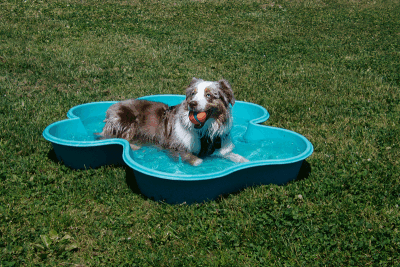METRO DETROIT — With temperatures breaking records around the globe, experts are advising pet owners to be careful when exposing animals to summer heat.
Jennifer Thomas, the animal control officer for Hazel Park, said this is especially critical when it comes to vehicle travel.
“The main thing for people to remember is to never leave pets in the car. If you can’t take the animal with you to the store, or wherever, just leave it at home,” Thomas said. “Even cracking open the window doesn’t do much for the internal heat of a car. It builds up extremely quickly.”
Paige Wallace, the animal control officer for Madison Heights, noted that cracked windows allow the air to just barely skim the surface of the roof of the vehicle, which provides little relief for a pet that sits down low. She said the interior is often 20 degrees hotter than the air outside. Other factors, such as the color or materials of the interior, can also affect the heat. For example, leather seats warm up quickly and can burn animals.
“If the humidity is high, and there is stagnant air, they could have limited oxygen,” Wallace said via email. “Dogs such as pugs, boxers and shih tzus have a harder time breathing in extreme heat, due to their short muzzles. Cats, huskies, German shepherds and anything with an undercoat have no business being out in extreme heat. Their fur can suffocate them and alter the feeling of how hot they really are, putting them in heat distress quicker.”
Both officers advise caution when walking pets outside this time of year. While people wear shoes that protect the soles of their feet, dogs and cats have sensitive paw pads that can hurt when walking on hot concrete. Before walking, touch the sidewalk or road with your hand to see if it’s cool. Don’t assume that it’s safe just because it’s shaded. A dog starting to limp, or excessively licking and tending to one paw, may indicate the ground is uncomfortable for them.
Once you return from the walk, if the pet likes the hose, spraying them lightly but consistently until the water gets through their coat can provide relief. Once inside, provide them water to drink but monitor intake, since excessive amounts can cause bloat, which can be deadly.
One major sign of heat distress is the animal looking “bug-eyed,” with its eyebrows raised, and the whites of its eyes showing more. The eyes may frantically look from side to side, and the tear stains may darken as the eyes water. The eyes may also appear red or bloodshot.
Other signs include labored breathing and panting so hard the body moves with each breath. Alternatively, the animal may appear exhausted, moving very little. Another sign is the pet continually moving from one shaded spot to the next or trying to dig into the ground where it’s cooler. The ears pointing back is yet another possible sign.
Keeping pets in an air-conditioned space is best, Wallace and Thomas said. If there’s no AC, open the windows and point a couple of fans in the direction of the pet. Whether inside or outside, animals should have access to clean drinking water just below room temperature at all times. If there is green algae growth or dirt in the bowl, empty it and wash it immediately before refilling it with water. As for the best diet this time of year, the officers recommend a high-protein, high-carb, low-fat diet.
Any shelter structure outside must allow for proper air flow, so the pet inside doesn’t feel hot.
“Under no circumstance is a garage an adequate shelter in the summer,” Wallace said.
In general, do not allow pets outside in extreme heat for longer than 30 minutes at a time.
Wallace and Thomas also noted that thunderstorms and fireworks during the summer can cause stress for animals. Pets should never be outside during either event.
Instead, keep them indoors, close windows and cover them in heavy blankets. Secure them with snuggles, and turn on children’s cartoons with many noises to drown out the thunder or fireworks.
“If that doesn’t work, take them to a basement and continue to comfort them,” Wallace said. “Do not leave them alone — they will become destructive as a coping mechanism to trigger stacking.”
She explained that “trigger stacking” is when animals experience multiple stimuli back to back — for example, rolling peals of thunder or repeat firework detonations. They don’t have a chance to recover or decompress from one boom before the next, which causes their emotions to stack and their adrenaline to spike. This not only hurts the animal but can also cause them to harm their environment by tearing up furniture, bedding and wallpaper.
Thomas said it’s important for pet owners to tune into the feelings of their pets and to play it safe if they’re not sure how their pet is feeling.
“Don’t underestimate the heat,” Thomas said. “Please be careful.”
 Publication select ▼
Publication select ▼























